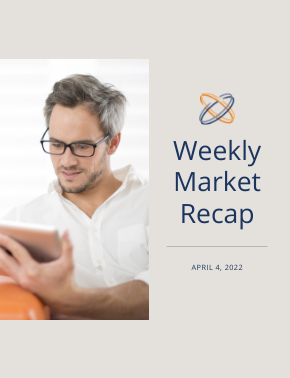Week in Review
Equity Markets:
The S&P ended the first quarter down just under 5%, the first quarterly decline since the start of pandemic two years ago. On the heels of a ~10% run over the past few weeks, the S&P 500 fought back the final month of the quarter and ended March up 3.6%. Broadly speaking, financially healthy consumers and corporations helped the market recover despite the two major head winds of rising interest rates and the war in Ukraine.
It appears the conflict in Ukraine may be starting to take a turn. Early in the week, there were discussions of de-escalation and Ukraine’s inclusion in the EU. Talks stalled later in the week, which was likely a contributor to the choppy week’s ending in the markets.
Fixed Income Markets:
The yield curve garnered much of the attention last week. The heavily followed 2’s/10’s spread turned negative. This means that the 2-year treasury note has a higher yield than the 10-year treasury as market participants anticipate the equity market will struggle in the near term. As of the market close, the 2-year treasury had a yield of 2.46% while the 10-year yielded 2.39%.
The recent hike in the Fed fund’s rate made this a likely possibility with the low interest rate environment that has existed for the past two years.
Economic:
The economy added 431,000 jobs in March and the unemployment rate fell to 3.6%. Both figures show the labor market is strong. The ISM Manufacturing Index contracted slightly to 57.1 but remains in expansion territory.
The personal consumption expenditure (PCE) price index increased 5.4% year over year, excluding food and energy. PCE is an important inflation measure the Fed tracks when setting monetary policy. This reading was the highest since 1983.
Looking Ahead
Equity Markets:
The market has recovered the majority of losses incurred to start the year, but a volatile road ahead is likely. Earnings expectations have been ratcheted down for Q1 2022 with 67 S&P 500 companies issuing negative earnings guidance according to FactSet. The forward P/E ratio stands at ~19.5x, which is above the five-year average of 18.6x. The changing interest rate environment will highlight the potential for multiple market compressions going forward.
The backdrop may not be ideal for an equity market return, but it is important to remember that the environment does not have to be perfect to see positive performance. The yield curve inversion has now been added to the market concerns along with higher interest rates and the war in Ukraine.
According to JP Morgan, equity markets tend to do well after the curve inverts with average returns between 20-25% before stocks peak. This is why we believe it is extremely important to be invested in a long-term strategy that fits your risk tolerance. Volatility is likely to remain high, but with volatility comes the potential for further gains.
Fixed Income Markets:
It is important for investors to understand that an inverted yield curve does not dictate a certain outcome. Although an inversion has preceded many recessions, it has had false positives. The phenomenon also has several nuances. History has shown that there is a correlation between an inverted yield curve and a recession at some point in the future. On average over the past four 2-year/10-year yield curve inversions, it’s taken 17.1 months for the market to peak and 21 months until recession started, according to Ryan Detrick of LPL Research. But correlation and causation are very different matters.
We believe that an inverted yield curve is more of an alert than a flashing red warning. If the inversion lasts for a matter of months and waterfalls down to shorter maturities, the likelihood of recession increases greatly in our opinion. Academics believe if the 30-day bill and the 30-year note invert, that may be seen as a high probability of recession.
Economic:
The services PMI and FOMC March meetings will garner heavy attention this week. We will also get the jobless claims numbers for last week and the trade balance.
Important Disclosures:
Investment Advisory Services offered through Krilogy®, an SEC Registered Investment Advisor. Please review all prospectuses and Krilogy’s Form ADV 2A carefully prior to investing. This is neither an offer to sell nor a solicitation of an offer to buy the securities described herein. An offering is made only by a prospectus to individuals who meet minimum suitability requirements.
All expressions of opinion are subject to change. This information is distributed for educational purposes only, and it is not to be construed as an offer, solicitation, recommendation, or endorsement of any particular security, products, or services.
Diversification does not eliminate the risk of market loss. Investments involve risk and unless otherwise stated, are not guaranteed. Investors should understand the risks involved of owning investments, including interest rate risk, credit risk and market risk. Investment risks include loss of principal and fluctuating value. There is no guarantee an investing strategy will be successful. Past performance is not a guarantee of future results. Indices are not available for direct investment; therefore, their performance does not reflect the expenses associated with the management of an actual portfolio. The S&P data is provided by Standard & Poor’s Index Services Group.
Services and products offered through Krilogy® are not insured and may lose value. Be sure to first consult with a qualified financial advisor and/or tax professional before implementing any strategy discussed herein.




















